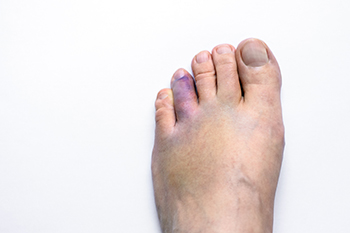
A broken toe can cause pain, discomfort, and temporarily change the way daily activities are accomplished. A broken toe is difficult to walk on, and rest is needed to accelerate recovery. Some patients may find it helpful to use crutches, which can keep the weight off of the toe. A broken toe can happen from stubbing it on a piece of furniture, enduring an injury, or dropping a heavy object on it. Fractured toes may occur more often than breaking other bones in the body. This is because the bones in the toes are small, and are located at the end of the body. Common symptoms of this type of injury can consist of immediate bruising, swelling, and the affected area may be red. If a toe is severely broken, a bone may protrude through the skin and can appear to be deformed. Many people have positive results in using the buddy taping method for treatment. This can be successful in less severe fractures and is done by taping the broken toe to the toe next to it. If you have broken your toe, please schedule an appointment with a podiatrist sooner rather than later who can guide you toward the correct treatment method.
A broken toe can be very painful and lead to complications if not properly fixed. If you have any concerns about your feet, contact Frederick Matthews, DPM from Innovative Foot and Ankle Care. Our doctor will treat your foot and ankle needs.
What to Know About a Broken Toe
Although most people try to avoid foot trauma such as banging, stubbing, or dropping heavy objects on their feet, the unfortunate fact is that it is a common occurrence. Given the fact that toes are positioned in front of the feet, they typically sustain the brunt of such trauma. When trauma occurs to a toe, the result can be a painful break (fracture).
Symptoms of a Broken Toe
- Throbbing pain
- Swelling
- Bruising on the skin and toenail
- The inability to move the toe
- Toe appears crooked or disfigured
- Tingling or numbness in the toe
Generally, it is best to stay off of the injured toe with the affected foot elevated.
Severe toe fractures may be treated with a splint, cast, and in some cases, minor surgery. Due to its position and the pressure it endures with daily activity, future complications can occur if the big toe is not properly treated.
If you have any questions please feel free to contact our office located in Plano, TX . We offer the newest diagnostic and treatment technologies for all your foot and ankle needs.
